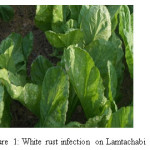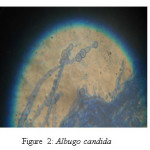Introduction
Rapeseed – mustard is one of the most important cruciferous crops. This crop is basically cultivated for oils and vegetables during winter season in Manipur. This crop provides both domestic consumption of oils and vegetables to the marginal farmers. Pests and diseases are the major constraints which hamper the cultivation of this crop and its productivity. More than 30 diseases are known to occur on Brassica crops including rapeseed – mustard in India.1 The major constraints of rapeseed – mustard is fungal diseases , of which white rust is the most common . White rust caused by Albugo candida (Pers.) Kuntze which occurred various parts of the world causes tremendous yield losses in mustard.2 Management of pests and diseases through agronomic practices includes crop rotation, utilization of disease free seeds, burning of infected plant debris, soil solarization, sowing date , intercropping , plant density etc. These practices are widely followed in the traditional system of disease management in Manipur. Attempts have been made in the present investigation to find out the suitable agronomic practices for the control of white rust on rapeseed- mustard because traditional agronomic practices are not only cost effective but also sustainable, subsistence in agriculture. Keeping in view, the present investigation was carried out with the most important three traditional agronomic practices that include intercropping , plant density and date of sowing in the management of white rust of rapeseed- mustard under organic farming.
Materials and Methods
Field Trials
Field experiments were conducted at Kakching , an agricultural hub of diverse crops, located in 24 29′ 30″ N latitude and 9359′ 30″ E longitude at 45 Km away from Imphal, Manipur for two consecutive winter seasons (2014 & 2015 ). The field has an earlier record of growing seasonal vegetables including mustard . Field experiments were conducted on two rapeseed varieties [B. rapa (L.) var. M-27 (V3) , Brassica rapa (L.) var. ragini (V4) ], and two local mustard cultivars [ B. juncea (L.) Czern. & Coss. cv. Local Yella (V1) and B. juncea (L.) Czern.& Coss. cv. Lamtachabi (V2) ]. Seeds were sown in the last week of October except for date of sowing ( DOS) experiment in plots [(2.2 X 1.3) m2 ] keeping some border line with three replications and raised under irrigated condition using farmyard manures (FYM) as done by traditional farmers starting from September to November. For DOS experiment seeds were sown at five different dates viz., D1, D2, D3, D4 and D5 (30.09.14 , 15.10.14 , 30.10.14 , 14.11.14 and 29.11.14 ) by maintaining 15 days interval. A spacing of ( 30 x 10) cm2 row to row and plant to plant distances were maintained except for the plant density field experiment. For plant density experiment different spacing viz., T1= (20 X 5) cm2, T2 = (30 X 10) cm2 and T3 = (40 X15 ) cm2 were selected to evaluate their effect on white rust disease severity in the experimental varieties. A ratio of 5:1 with rapeseed and 3:1 with mustard were maintained for observing intercropping effect with Pea (Pisum sativum L.) . A weekly monitoring was conducted 45 DAS ( Days After Sowing ) and it extended from November to February in each year. Data on disease severity of rapeseed – mustard were rated using 0 – 6 scale.3
Data analysis
Disease severity data were statistically analyzed using one way ANOVA and t – test at 5% level of significance to evaluate any variance of white rust severity among various treatments of agronomic practices . MS – Excel was used for statistical computation of the data.
Isolation of the pathogen and identification
White rust infected leaves ( 5 for each variety) were brought to the lab using sterile poly-bags. The fungal pathogen was isolated by following the method4 in the laboratory. The infected plant tissues along with unaffected tissue were cut into pieces ( size : 2- 5 mm 2). With the help of sterilized forceps, the inoculants were transferred to sterile petri – plates containing 0.1% mercuric chloride solution and later they were surface sterilized for 30 seconds. The sterilized pieces @ 3 – 5 per plates were inoculated in BNPRA5 medium. The inoculated petri- plates were incubated at 25 – 27 1 and observed after 5 days.
After the incubation period the growth of fungi was studied under microscope . By comparing the reproductive structures as revealed in microscopic observation with standard literature,6 the pathogen was identified.
Results and Discussion
Intercropping provides significant effects on disease severity (DS ) of the crop than sole cropping (Table 1). It may be accounted that intercropping helps to avoid inter-crop competition and thus a higher number of crops can be grown per unit area at a time which enables efficient
Table 1: Effect of rapeseed-mustard and pea intercropping against white rust (DI and DS -pooled for two years i.e. rabi 2014 & 2015)
| Treatments |
DI (%) |
DS (%) |
||||||
| V1 | V2 | V3 | V4 | V1 | V2 | V3 | V4 | |
| Intercropping | 47.21 | 48.63 | 26.72 | 25.73 | 14.31 | 15.33 | 12.80 | 12.29 |
| Control | 46.84 | 49.19 | 27.77 | 28.32 | 16.32 | 17.29 | 14.99 | 14.81 |
| t-value (5%) | *19.64 | *10.23 | *18.34 | *25.76 | ||||
*Significant at 5% level of significance; DI = Disease Incidence, DS = Disease severity.
Table 2 : Effect of plant density against white rust of rapeseed –mustard (DI and DS –pooled for two years i.e. rabi 2014 & 2015 )
| Treatments |
DI (%) |
DS (%) |
||||||
| V1 | V2 | V3 | V4 | V1 | V2 | V3 | V4 | |
| T1 | 37.64 | 39.87 | 22.83 | 22.58 | 16.01 | 16.25 | 12.90 | 12.14 |
| T2 | 40.25 | 41.41 | 24.25 | 24.93 | 14.04 | 14.84 | 11.63 | 10.86 |
| T3 | 37.27 | 41.78 | 25.36 | 24.25 | 11.03 | 12.70 | 10.47 | 9.57 |
| C.D. (5%) | *0.37 | *0.37 | *0.51 | *0.36 | ||||
*Significant at 5% level of significance.
Table 3: Effect of date of sowing against white rust of rapeseed –mustard ( DI and DS –pooled for two years i.e. rabi 2014 & 2015 )
| Treatments |
DI (%) |
DS (%) |
||||||
| V1 | V2 | V3 | V4 | V1 | V2 | V3 | V4 | |
| D1 | 37.65 | 39.81 | 22.83 | 22.59 | 12.97 | 14.54 | 11.30 | 11.06 |
| D2 | 42.52 | 43.36 | 24.25 | 24.93 | 13.75 | 14.80 | 11.43 | 11.68 |
| D3 | 45.02 | 46.17 | 25.30 | 26.47 | 13.45 | 13.80 | 11.82 | 11.55 |
| D4 | 46.36 | 48.27 | 29.13 | 30.86 | 15.04 | 16.35 | 13.61 | 13.30 |
| D5 | 49.90 | 50.80 | 29.74 | 30.67 | 17.74 | 18.08 | 12.71 | 11.75 |
| C.D. (5%) | *0.15 | *0.18 | *0.29 | *0.22 | ||||
*Significant at 5% level of significance.
 |
Figure 1: White rust infection on Lamtachabi (V2) Click here to View figure |
 |
Figure 2: Albugo candida Click here to View figure |
resource utilization and increased productivity probably by minimizing disease level. This finding corroborated with the findings7 who reported that suitable intercropping systems were more favorable to control diseases without chemicals comparing with monoculture. Similar findings in other crops were also reported.8
Plant density treatments showed significant effect on the experimental varieties used (Table 2). Treatment, T3 was found to be most effective where least disease severity was encountered. By virtue of different spacing in plant density treatments viz., T1 [(20X5) cm2], T2 [(30×10) cm2] and T3 [(40X15 ) cm2] the number of plants per plot varies. DS values were found increased in T1 while reduced in T3 than T2 treatment. It may be attributed that more nutrient uptake and utilization for proper growth of the crop was facilitated by enough space availability around the crop. Similar findings that reduction in spacing between plants increased the incidence of seed borne infection in rice.9
Statistically significant variance was resulted among the treatments of sowing date (Table 3). The highest DS (18.08% ) was found in V2 sown on D5 ( 29.11.14) while the least DS (11.06%) in V4 sown on D1 (30.09.14). Thus sowing of rapeseed- mustard varieties earlier than D3 (30.10.14) resulted less DS even though there was some fluctuations in D2 treatment if late higher DI and DS encountered. However, for rapeseed varieties DS values first increased and then reduced when sown late. These variations may be due to the fact that the rapeseed varieties mature earlier than mustard varieties hence congenial physiological stage of the crop was not found to infect in the former. Meantime they were susceptible for other diseases such as powdery mildew. Early sown crops on 30.09.14 (D1) can recede the crop from damages caused by white rust. Various authors10, 11 also detected similar findings that higher disease intensity under late sown conditions in rapeseed –mustard. In an overall assessment the least DI( 22.59%) & highest DI ( 50.80% ) were detected in DOS treatments. The least DS ( 9.57%) was found in plant density followed by date of sowing (11.06% ) and intercropping (12.29%) experiments. Thus among the agronomic practices evaluated plant density was found to be most effective followed by date of sowing and intercropping.
Conclusion
Traditional agronomic practices particularly the plant density were found to be effective in the management of white rust under organic farming system in Manipur’s agro-climatic condition. Thus the farmers may adopt these traditional agronomic practices to raise the crop successfully.
Acknowledgements
The Author gratefully acknowledges the receipt of Manipur University research fellowship and head, Centre of Advanced Study in Life Sciences, Manipur University ,Canchipur, Imphal for providing laboratory facilities.
References
- Saharan G..S. Management of rapeseed – mustard diseases. In: Kumar D and Rai M (eds.). Advances in oilseed research. Vol. 1 Rapeseed and Mustard Scientific Pub. Jodhpur. 1992;155–188.
- Bains S.S and Jhooty J.S. Mixed infections by Albugo candida and Peronospora parasitica on Brassica juncea inflorescence and their control. Indian Phytopathol. 1979;32:268-271.
- Barbetti M.J, Li C.X , Banga, S.S, Banga S.K , Sandhu P.S , Gurung A.M and Salisbury P.A. High level resistance against white rust (Albugo candida) race 2V identified in Brassica juncea genotypes from China and Australia. 13th International Rapeseed Congress June 5-9, Prague, Czech Republic. 2011.
- Narayanasamy P. Microbial Plant Pathogens – Detection and Disease Diagnosis: Fungal Pathogens, vol. 1, Springer Science & Business Media. 2010;9.
- Masago H, Yoshikawa M, Fukada M. and Nakanishi N. Selective inhibition of Pythium spp. on a medium for direct isolation of Pytophthora spp. from soils and plants. Phtytopathol. 1977;67:425-428.
CrossRef - Singh R. S. Plant Diseases, 9th Edition. Oxford & IBH Publishing Company Pvt. Ltd. India, 2009;173-393.
- Gomez- Rodriguez O , Zavaleta – Mejia E , Gonzalez-Her nandez V.A, Livera-Munoz M and Cardenas-Soriano E. Allelopathy and microclimatic modification of intercropping with marigold on tomato early blight disease development. Field Crop Res. 2003;83:27-34.
CrossRef - Abdel-Monaim M.F and Abo-Elyousr K.A.M. Effect of preceding and intercropping crops on suppression of lentil damping – off and root rot disease in New Valley – Egypt. Crop Prot. 2012;32:41- 46.
CrossRef - Agarwal, V.K , Singh O.V and Modgal S.C. Influence of different doses of nitrogen and spacing on seed- borne infection of rice. Indian Phytopathology. 1975;28:38-40.
- Saharan G.S. A review on research on rapeseed-mustard pathology in India. Paper presented in the Annual Rabi Oilseed Workshop, held at Jaipur, 6-10 August. 1984.
- Gupta K, Saharan G.S and Singh D. Assessment of white rust severity on Brassica juncea under genotype-environment interactions. J. Mycol and Pl. Path. 2002;32:106-109.

